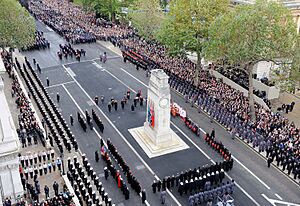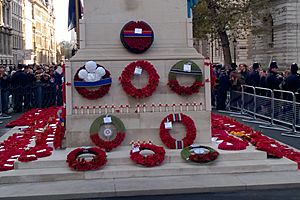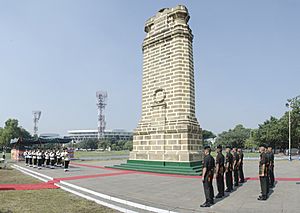Remembrance Sunday facts for kids
Quick facts for kids Remembrance Sunday |
|
|---|---|
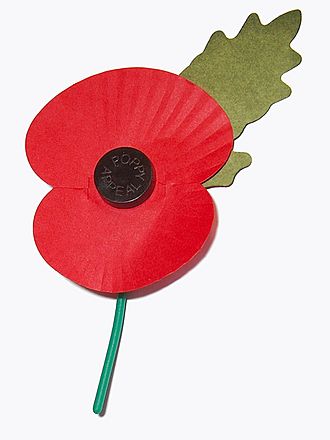
The poppy is worn around the time of Remembrance Sunday (traditionally from All Souls' Day (2 November) until the later of; Remembrance Day (11 November) or Remembrance Sunday)
|
|
| Official name | Remembrance Sunday |
| Observed by | United Kingdom |
| Liturgical color | (Red or green) |
| Observances | Parades, silences |
| Date | Second Sunday in November |
| 2025 date | November 9 |
| 2026 date | November 8 |
| 2027 date | November 14 |
| 2028 date | November 12 |
| Frequency | Annual |
| Related to | Remembrance Day and Armistice Day |
Remembrance Sunday is a special day in the United Kingdom. It is a time to remember all the brave British and Commonwealth soldiers, sailors, and air force members. It also honors civilians who helped during the two World Wars and other conflicts. This day happens on the second Sunday in November. This Sunday is usually the one closest to November 11th, which is Armistice Day. Armistice Day marks the end of World War I in 1918.
On Remembrance Sunday, ceremonies take place at war memorials in towns and villages. Important people like local leaders and former service members attend. Members of the armed forces and youth groups like Scouts and Guides are also there. People lay poppy wreaths on the memorials. Everyone observes a two minutes' silence at 11 AM. Church bells often ring softly, making the atmosphere very serious. The whole event, including parades and services, usually lasts about two hours.
Contents
The History of Remembrance Sunday
Remembering those who died in World War I first happened on Armistice Day itself, starting in 1919. There were national events in London and local ceremonies in towns. These often included parades of important people and veterans.
First Commemorations
The very first UK event to mark the end of World War I was at Buckingham Palace. King George V hosted a dinner on November 10, 1919. The first official Armistice Day events were held at the Palace on November 11, 1919. This included a two-minute silence at 11 AM. This silence was to show respect for those who died and their families. While people were very happy when the war ended in 1918, some felt the 1919 dinner was too much like a party.
The Unknown Soldier and Poppies
In 1920, on Armistice Day, the funeral of the Unknown Soldier took place. This was at the London Cenotaph. A two-minute silence was observed across the whole country. Buses stopped, trams lost power, and even trading on the London Stock Exchange paused.
Starting in 1921, the Royal British Legion began selling Remembrance Poppies. They sold them to raise money for former service members. Through the 1920s and 1930s, how people remembered the day changed. For some, Armistice Day was about the terrible parts of war, hoping it would never happen again. For others, it was about honoring military service.
Changes During World War II
During the Second World War, the remembrance events were moved. They happened on the Sunday before November 11th. This was an emergency step to avoid stopping the production of important war materials.
In May 1945, after the war ended, leaders discussed the future of remembrance. Armistice Day in 1945 fell on a Sunday, so no change was needed that year. Some thought keeping November 11th would focus too much on World War I. They wanted to also honor those from World War II. Many different dates were suggested. The Archbishop of Westminster suggested the second Sunday in November. He wanted it to be called Remembrance Sunday to remember both World Wars. This idea was accepted by the government in 1946. Clement Attlee, the prime minister, announced it to the House of Commons.
National Ceremony in the United Kingdom
The main ceremony takes place in London at the Cenotaph. This monument is on Whitehall. It starts with a two minutes' silence at 11 AM. The most important part is when members of the royal family and other important people lay wreaths. There is also a service with prayers and a hymn. After this, thousands of former service members and other groups march past. They salute the Cenotaph as they go by.
Regional and Local Ceremonies
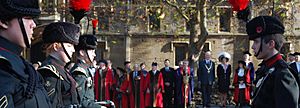

Important ceremonies also happen in the capitals of the UK nations. These include the Scottish National War Memorial in Edinburgh and the Welsh National War Memorial in Cardiff. In Belfast, ceremonies are held at the Northern Ireland War Memorial and Cenotaph.
Typically, poppy wreaths are laid by representatives of the Crown and the armed forces. Local leaders and groups like the Scouts and Guides also lay wreaths. The start and end of the silence are often marked by the firing of an artillery piece. A minute or two minutes of silence is also often part of church services.
Some people believe that Remembrance Sunday ceremonies focus too much on military members. They feel that the many civilians who died in wars are sometimes forgotten.
British Overseas Territories
In the past, a government official laid a wreath for all the British overseas territories. However, since 2001, these territories have asked for the right to lay their own wreath. In 2008, the government agreed. Now, a representative from the territories can lay one wreath for all 14 territories at the Cenotaph service.
Remembrance in Northern Ireland
In Northern Ireland, Remembrance Sunday is often linked with unionists. Most Irish nationalists and republicans usually do not take part in these public events. This is partly because of the actions of the British Army during The Troubles. It is also due to their role in past conflicts against Irish independence. However, some moderate nationalists have attended these events. They see it as a way to connect with the unionist community.
In 1987, a bomb exploded just before a Remembrance Sunday ceremony in Enniskillen. Eleven people were killed. The group responsible said it was a mistake and they had been targeting soldiers. The Republic of Ireland has its own National Day of Commemoration in July. This day remembers all Irish people who have died in war.
Other Remembrance Ceremonies
From 1919 to 1945, Armistice Day was always on November 11th. It then moved to Remembrance Sunday. But since 1995, ceremonies are often held on both Armistice Day and Remembrance Sunday.
In 2006, Gordon Brown suggested a new national day to celebrate veterans. This "Veterans Day" would be held in the summer. It would be similar to Veterans Day in the United States. This day is now called "Armed Forces Day". It includes serving troops, their families, veterans, and cadets. The first Armed Forces Day was on June 27, 2009.
Submariners also have their own remembrance walk and ceremony. This happens on the Sunday before Remembrance Sunday. It focuses on The Submariners Memorial in London.
Remembrance Outside the United Kingdom
Outside the UK, Anglican and Church of Scotland churches often have a service on Remembrance Sunday. In the Republic of Ireland, there is a service in St Patrick's Cathedral, Dublin. Since 1993, the President of Ireland has attended this service.
The Anglican Church of Korea also celebrates this day. They remember the Commonwealth soldiers who fought in the Korean War. A service is held at the Seoul Anglican Cathedral.
In New Zealand, there was an attempt to change Armistice Day to Remembrance Sunday after World War II. But it did not succeed. This was partly because of Anzac Day, which is also a major day of remembrance there.
Every year, the British Deputy High Commission in Kolkata, India, holds a Remembrance Sunday event. It takes place at the Glorious Dead Cenotaph.
Poppies: A Symbol of Remembrance
Remembrance poppies are a very important symbol of Remembrance Sunday. People wear them on their clothes. They are also made into wreaths. The Royal British Legion sells red paper poppies to raise money.
Sometimes, there are discussions in the news about people who choose not to wear a red poppy. Some critics call this "poppy fascism." This is because people who do not wear poppies on TV or at sports events have sometimes received angry messages. This shows that while the poppy is a symbol of unity for many, it can also lead to different opinions.
See also


